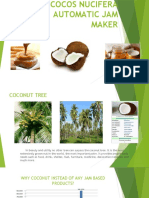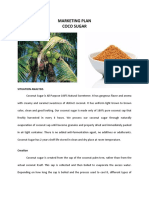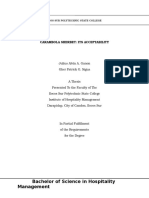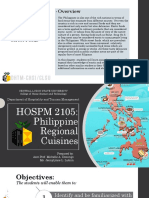Native Delicacies
Native Delicacies
Uploaded by
HtebyleL RaniloPCopyright:
Available Formats
Native Delicacies
Native Delicacies
Uploaded by
HtebyleL RaniloPCopyright
Available Formats
Share this document
Did you find this document useful?
Is this content inappropriate?
Copyright:
Available Formats
Native Delicacies
Native Delicacies
Uploaded by
HtebyleL RaniloPCopyright:
Available Formats
Native delicacies, known as kakanin in Filipino, are popular snack foods that are usually served as desserts.
Kakanin are usually prepared whenever there is a special occasion like fiesta, birthday, Christmas, anniversary, etc. No celebration is complete without these kakanin being served in the table. Because of its popularity among Filipinos here and abroad, many household mom entrepreneurs saw the need for commercializing it into a kakanin business, knowing that this type of industry can be easily manufactured at home. From traditional ways of cooking and selling, native kakanin delicacies have now reached major mall food stalls around the country. And, from unsophisticated plastic wrappers, kakanin are now gracefully stuffed in polystyrene foam (commonly known as Styrofoam) with printed labels on them. No doubt, these generated income opportunities to many Filipinos. Just like any other business, you must first get to register your kakanin business. Follow these steps in business registration. You must also get your products approved by the Bureau of Food and Drugs. The important thing that you must do before going into this kind of business, if you dont have any experience, is to get a training. You can get that one thru DTI-sponsored seminars and trainings and to any other training institutions. This is one way of educating and empowering you as an entrepreneur. Below are list of Filipino kakanin delicacies which you can use to start a small kakanin business. (Note: some descriptions were taken from the source sites) Biko is a Filipino rice cake made from sticky rice (locally known as malagkit), coconut milk, and brown sugar. Like other rice cakes, this is referred to as kakanin (derived from the word kanin which means rice) and is often eaten as dessert or meryenda (mid-afternoon snack). Biko recipe here- panlasangpinoy.com Kalamay hati a native kakanin or rice cake. It is made from ground sticky rice, sugar, mascuvado, coconut milk and sesame seeds. It is brownish in color; it is very sticky that you will almost spend your whole time chewing it. Kalamay hati recipe here -iloveiloilo.com Sinabalo (Suman) this suman recipe is from Cagayan Region II. Instead of wrapping the malagkit in banana leaves, it is broiled in fresh bamboo tubes. Sinabalo (suman) recipe herefilipinovegetarianrecipe.com Palitaw made from glutinous rice and sugar, sprinkled with sesame seeds and topped with grated coconut. Theyre very soft and easy to chew and are best served cold. Palitaw recipe hereeasymealrecipes.blogspot.com Espasol kakanin dessert made out of glutinous rice, coconut milk, shredded coconut, rice flour. Espasol recipe here -easymealrecipes.blogspot.com
Tupig made from glutinous or malagkit rice flour, coconuts, molasses, sesame seeds, wrap in banana leaves and baked over live charcoal. Tupig recipe here- filipinovegetarianrecipe.com Cassava cake a classic Filipino dessert made from grated cassava or manioc, a woody shrub where the starch that is used to make tapioca are derived. Cassava cake recipe here panlasangpinoy.com Special Puto a steamed rice muffin which is of a plain white color but adding certain common Filipino ingredients like coconut milk, ube and pandan (made from pandan leaves) slightly changes the flavor and completely changes the color of the finished product. Special puto recipe here. Cuchinta (kutsinta) a native delicacy in the Philippines. Its a sticky, golden brown, sweet dessert popular among Filipinos. Cuchinta recipe here. -easymealrecipes.blogspot.com Maja Blanca a cake made out of rice flour, coconut milk with addition of milk to make it more tastier and creamier, top with latik. Maja blanca recipe here. -easymealrecipes.blogspot.com Puto Bumbong a steamed glutinous (malagkit) rice mixture which is popular during Christmas season. Puto bumbong recipe here filipinovegetarianrecipe.com Buchi or Butsi a rice cake made from sweet rice flour that is molded into shape with a sweet bean paste filling and sesame seed coating. This delectable treat is deep fried under high heat before serving. Buchi recipe here- panlasangpinoy.com Sapin- Sapin a native dessert consists of coconut milk, ube powder, gelatin and corn kernels. Sapin-sapin recipe here -filipinovegetarianrecipe.com Ube Halaya a native dessert made of mashed purple yam and condensed milk. Ube halaya recipe -pinoyfoodblog.com Bibingkang Malagkit a rice cake made out of glutinous rice, coconut milk and brown sugar. Bibingkang malagkit recipe here easymealrecipes.blogspot.com Buko Pie an all-time favorite traditional Filipino pastry style, young-coconut-filled pie. Buko pie recipe here easymealrecipes.blogspot.com With this kind of business, it is also good to complement it with Binignit, champorado, buko pandan or even halo- halo. Kakanin Business Tips: - Join any capability-enhancement trainings to boost your morale - Adopt new better technology to increase production and to improve the shelf life of kakanin. - Formulate new marketing strategies to broaden your niche.
Do you like this money making business idea? then please consider subscribing to our RSS feed and have new articles sent directly to your inbox. Related Search Terms: kakanin business, kakanin, kakanin recipe, puto pao recipe panlasang pinoy, panlasang pinoy com, filipino kakanin, kakanin recipes, panlasang pinoy kakanin
Enkiwar (Puto with Coconut Milk) puto recipe with coconut milk made from glutinous rice. Tibok-Tibok ( Carabaos Milk Pudding ) a native pudding recipe made from carabaos milk instead of the usual coconut milk. Cebuano Corn Pudding a native delicacy pudding made by cebuanos made from young corn kernels, buko meat and milk. Budbud Pilipit a glutinous rice delicacy cooked with coconut milk. Similar to suman, wrapped in banana leaves and steamed. Pineapple Cassava Bibingka a unique cassava bibingka for you to try. Makes a good addition if you are selling kakanin. Maja De Ube an exciting way to make maja. This version is made with a combination of mashed ube or purple yam. Ginataang Pinipig a delicious native dessert of fresh green pinipig cooked in coconut cream and mixed with cubed gabi or taro root, sweet potatoes, jackfruit and saba bananas. Milk Puto Recipe a rich tasting puto loaded with milk, corn and buko. Perfect for any occasion. Sinabalo (Suman) this suman recipe is from Cagayan Region II. Instead of wrapping the malagkit in banana leaves, it is broiled in fresh bamboo tubes. Butse-Butse this native dessert is from central visayas region VII. Composed of mashed sweet potato formed into balls and stuffed with grated cassava inside. Binu-Hang Gabi this stuffed taro root recipe is an authentic native dessert from central visayas region VII. Baye-Baye A Western Visayas Region VI dessert delicacy made from toasted pinipig, coconut water and grated young coconut. Iraid A native delicacy from Bicol region V a combination of cassava and sweet potatoes with coconut milk and brown sugar then wrapped in banana leaves.
Kalingking this native delicacy is from Bicol region V Binaki this delicacy is from Northern Mindanao Region 10 Bocarillo an eastern visayas sweet made from sweetened grated coconut with eggs and milk. Binagol (or Binangol) This is a visayan delicacy. Sweetened shredded gabi tuber with coconut and condensed milk then cooked in coconut shells and wrapped in banana leaves. Maja Blanca a real version of maja blanca with additon of milk to make it more tastier and creamier. Putong Bigas (Putong Puti) - steamed puto made from ordinary rice. Minatamis na Saging na Saba procedure on how to make a sweetened bananas ( saba ) boiled with lemongrass and ginger with ice cream. Bibingka Cassava ( Kamoteng Kahoy ) bibingka made from grated cassava, coconut milk, eggs and sugar. Puto With Cheese is an all-time favorite kakanin or native delicacies. Native Halo Halo Halo Halo recipe that uses coconut milk instead of evaporated cows milk, mashed boiled ube and shredded young coconut meat. Baked Bilo-Bilo in Coconut Sauce bilo-bilo stuffed with monggo mixture ,poured with coconut sauce and then baked. Squash Cuchinta traditional cunchinta with squash. How to make Coconut Milk and Cream this topic will teach you how coconut milk and cream are made. Bibingkang Galapong (w/ picture) a rice cake made out of rice flour,coconut milk, eggs. Bibingkang Malagkit a rice cake made out of glutinous rice,coconut milk, brown sugar etc. Corn Maja a cake made out of rice flour,coconut milk, grated young coconut. Champorado native gruel made out glutinous rice, cocoa, milk and sugar. Simple Kutsinta ( Cuchinta ) a steamed cake made out of rice flour, sugar, water. Atchuete Kutsinta ( Cuchinta ) (w/ picture)- a steamed cake made out of all purpose flour with anatto seeds for coloring.
Brown Suga Kutsinta Cuchinta a steamed cake made out of all purpose flour, sugar, water and brown sugar. Espasol native dessert made out of glutinous rice, coconut milk, shredded coconut, rice flour. Ube Halaya dessert made of mashed purple yam and condensed milk. Mocha Choco Polvoron a powdery dessert made out of flour, powdered milk, cream, coffee, chocolate. Puto Bian Special a native steamed cake made out of brownie mix, eggs, cheese. Ginataang Munggo a sweet thick gruel made of glutinous rice, toasted monggo beans, coconut milk. Guavas With Coconut Cream boiled ripe guavas with coconut milk and sugar. Masapan De Pili nutty candies made out of pili nuts, sugar butter and egg yolks. Nilupak made from unripe cooked bananas ( saba variety ), young coconut meat, brown sugar. Palitaw famous native delicacy made from ground glutinous rice, sugar and shredded coconut. Pastillas De Mani or Pili a native candy made from condensed milk, ground nuts and corn syrup. Polvoron a powdery dessert made out of flour, powdered milk, sugar and butter. Tahada a native dessert made from pounded rice flakes, grated young coconut, milk and sugar. Taldis made from mashed boiled sweet potatoes, ground pili nuts, egg, coconut milk and vanilla. Squash Maja sweet cake made from squash, coconut milk, evaporated milk, corn starch and sugar. Maruyang Saba fried saba bananas coated with batter with eggs and milk. Cassava Cake tasty cassava cake for any occasion. Grahams Buko Pie a no bake easy to make delicious buko pie! Suman sa Ibos (w/ picture) famous suman wrap in buli leaves. Tamales a la Vegetarian a unique no meat tamales which is famous in pampangga, cavite.
Pichi-Pichi Espesyal a steamed cake made out of grated casava, sugar, water, coconuts. Puto Bumbong (w/ picture) a steamed malagkit rice mixture. Guinataang Halo-Halo saba bananas, camote, ube, langka boiled in coconut milk. Biko a steamed malagkit rice mixture. Sapin-Sapin (w/ picture) a native dessert consists of coconut milk,ube powder,gelatin,corn kernels. Bukayo with Pandan (w/ picture) a sweetened grated coconut, a famous delicacy with a slight variation. Binignit a sweet delicacy made out of gabi, ubi, tapioca, bananas boiled in coconut milk. Binalay made of glutinous rice, panocha. Masapan de Buko a sweet delicacy made out of buko,condensed milk,egg yolks,glazed fruit. Puto (Steamed Muffins With Anise Seed) steamed muffins made of flour,coconut milk and cream,anise seeds. Puto Caramba deep fried puto made from flour,shrimp,pinipig. Pastillas De Gabi ( Taro Root ) made out of young gabi or taro root,condensed milk sugar. Sapin-Sapin Palitaw Espesyal made from ground rice,nestle cream,macapuno,langka floating on syrup. Suman Sa Lihia made from glutinous or malagkit rice, lihia or lye, salt and wrap in banana leaves. Suman Sa Moron made from glutinous or malagkit rice, ordinary rice,coconut milk,peanuts. Tupig made from glutinous or malagkit rice flour, coconuts, molasses, sesame seeds, wrap in banana leaves and baked over live charcoal. Ube Kalamay made ube, mochico(sweet rice flour),coconut milk, latik and baked. Banana Pastillas pastillas made from saba bananas, sugar and butter. Umaalab Na Mangga ( Flaming Mango ) pancake with specially prepared syrup (bignay brandy , passion fruit concentraste) and garnished with sweetened mangoes and sago.
Kamote Pie (Sweet Potato Pie) our very own kamote or sweet potato made and baked into a delicious pie. Pili Pulp Cassava Cake a variation of cassava cake with pili pilp,pili nuts,cheese,eggs,milk. Sticky Turron Saba (w/ picture) turn your over ripe saba bananas to a gourmet dessert, sitcky turron saba caramelised, crispy and sticky. Maruyang Saging In Rum Butter Sauce a variety of maruyang saba (fried banana patties), mixed with special batter, fried and poured with rum butter sauce. Tinutong Na Monggo ginataang malagkit (glutinous rice cooked in coconut milk) with toasted monggo beans. Sinocmane glutinous rice cooked in coconut milk with camoteng ube,brown sugar,buko. Mango Pie a no bake pie made from ripe mangoes,gelatin,eggs. Ginataan Mais (w/ picture) glutinous rice or malagkit rice and scraped corn from a cob then cooked in coconut milk. Turones Filipino Con Yema a vareity of turon saba, dipped in yema and drizzled with melted chocolate and sprinkled with chopped toated cashew nuts and garnished with cherries. Polvoron Ala Pinipig polvoron or short cake made from cake flour,powdered milk,sugar and fried pinipig. Buko Pie the all time favorite original buko pie ! Biko Kalabasa biko or sticky rice combined with squash.
We Filipinos Love Our Native Desserts
The Philippines is not only known for its beautiful scenery and friendly people, it is also known for its delicious food. Among these foods are what we call the kakanins, native delicacies that are served as desserts. No party or celebration is complete without these Filipino desserts (we are known for our sweet tooth, too). Whats more interesting about them is that they (or their ingredients) tend to vary by region or by place. Another interesting fact is that a lot of Filipinos who are classified as "senior citizens" know how to make these desserts as they have already become part of the Philippine traditions. Featured below are some of these kakanins that are always a hit to Filipinos within and outside of the Philippines. Just a caveat, I don't really know how to make any of these but I love to learn. I love it more if I'm the one eating them LOL. =) Enjoy the hub!
Click thumbnail to view full-size
Puto these are rice cakes that are made from rice flour, evaporated milk (or coconut milk) and sugar (among others). They come in various colors (see picture). They can even come in bitesizes or they can just fill up a whole plate. Puto is best served with hot chocolate or dinuguan (as a replacement for rice). It is best eaten freshly baked and right out of the steamer. Kutsinta A brown rice cake, the kutsinta can go hand-in-hand with puto or they can be eaten all on their own (with freshly shaved coconut). They are also made from rice flour. Bibingka Another rice cake, this time made from malagkit rice (glutinous rice), coconut milk and brown sugar. Some variations of this will include bibingkang galapong (made from rice flour, coconut milk, baking powder and margarine), bibingka cassava (made from cassava, coconut milk and cream and margarine) and pineapple cassava bibingka. Suman Another steamed rice cake, this time, wrapped mummy-like in leaves before they are cooked. This can be served with sugar, grated coconut or latik milk solids from coconut that are formed when fresh coconut milk is boiled. Palitaw Made also from glutinous rice and sugar, these are also cooked with sesame seeds and topped with grated coconut. Theyre very soft and easy to chew and are best served cold. Sapin-Sapin (layers) A native colorful layered dessert, made from coconut milk, corn kernels, sugar, gelatin, whipped cream, ube (yam) powder and grated coconut. Pastillas de leche (milk candies) this is a milk-based pastry that comes in bite-sized pieces (great for snacking while youre traveling). It is literally made for those with a sweet-tooth because it is made from granulated white sugar and condensed milk. When cooked, it is formed into balls or logs and wrapped with cellophane paper. Maja Blanca Otherwise known as coconut cake, this is another all-time favorite Filipino dessert. It is made from coconut milk, sugar, cornstarch and/or corn kernels.
There are lots of Filipino desserts or delicacies out there. They can be very sweet and they are always favorites for the young and old alike. A lot of them show the Spanish influence in my country (as evidenced by their Spanish names). But one thing is for sure, we, Filipinos, love our desserts. In fact, wherever you go in the Philippines, you will surely encounter these kakanins. So if and when you decide to visit my wonderful country, be sure to try out our native desserts. Youll surely love them!
You might also like
- History of Philippine CuisineDocument2 pagesHistory of Philippine CuisineManny MontalaNo ratings yet
- Chapter 1 Introduction To Filipino and Regional CuisineDocument9 pagesChapter 1 Introduction To Filipino and Regional CuisineJUN GERONA100% (1)
- Cocos Nucifera Automatic Jam MakerDocument13 pagesCocos Nucifera Automatic Jam MakerErick AguadoNo ratings yet
- Puso NG Saging EmbutidoDocument4 pagesPuso NG Saging EmbutidoRiel Sevilla100% (1)
- Starting A Kakanin BusinessDocument10 pagesStarting A Kakanin BusinessRaven Parreño100% (1)
- Thesis Sensory Acceptability of Seafood Mix SoupDocument56 pagesThesis Sensory Acceptability of Seafood Mix SoupJm BalessNo ratings yet
- Marketing Plan Coco Sugar: Situation AnalysisDocument12 pagesMarketing Plan Coco Sugar: Situation Analysisqwerttrewq100% (2)
- Philippine Cuisine 1278 Orig.Document24 pagesPhilippine Cuisine 1278 Orig.Erjohn Bulos100% (4)
- The Significance of Preparing and Serving Native Delicacies To The Lives of IlocanoDocument16 pagesThe Significance of Preparing and Serving Native Delicacies To The Lives of IlocanoTorres, Emery D.100% (1)
- Asian Cuisines Lecture 06 - Philippine Regional CuisinesDocument2 pagesAsian Cuisines Lecture 06 - Philippine Regional CuisinesMervenn Aguado100% (1)
- Native Delicacies: By: Jhim BernardoDocument32 pagesNative Delicacies: By: Jhim Bernardomar cris velasco100% (1)
- Banana Peel VinegarDocument2 pagesBanana Peel VinegarJoe-Jean Laurio100% (1)
- Coconut JamDocument2 pagesCoconut JamPenny Low100% (1)
- Chapter I EditedDocument30 pagesChapter I EditedRhea Mae Joromat100% (1)
- Kakanin Rescued 104Document9 pagesKakanin Rescued 104Vladimere Censon ReyesNo ratings yet
- Chapter IiDocument16 pagesChapter IiLeslie AnasNo ratings yet
- Banana PeelDocument25 pagesBanana PeelKaye Ann CarelNo ratings yet
- Review of Related LiteratureDocument1 pageReview of Related LiteratureClara BelleNo ratings yet
- Ojt Polvoron Rimpy-BgDocument5 pagesOjt Polvoron Rimpy-BgBilly JoeNo ratings yet
- Chapter 2 and Synthesis MatrixDocument20 pagesChapter 2 and Synthesis Matrixhibiscus-eurie montillanaNo ratings yet
- SP1 - Leche Flan - Gavino - B5LDocument9 pagesSP1 - Leche Flan - Gavino - B5LShai GaviñoNo ratings yet
- POLMONUTDocument37 pagesPOLMONUTjelemebentulanNo ratings yet
- Chapter 1 FsDocument6 pagesChapter 1 FsNijinette TechezlarNo ratings yet
- Banana Vinegar Final 1Document12 pagesBanana Vinegar Final 1Shannen Cayyong TadeoNo ratings yet
- CHAPTER 1 Nov.25.2022 EditedDocument23 pagesCHAPTER 1 Nov.25.2022 EditedDaniella TiansayNo ratings yet
- Group 7 RRLDocument5 pagesGroup 7 RRLGrape JuiceNo ratings yet
- A Ppoject Feasibility Study On The Manufacturing of Vegan Longganisa in Guinayangan Quezon Facts and FiguresDocument5 pagesA Ppoject Feasibility Study On The Manufacturing of Vegan Longganisa in Guinayangan Quezon Facts and FiguresJoan AlfilerNo ratings yet
- What Is Longganisa (1-3)Document3 pagesWhat Is Longganisa (1-3)Lorie Mae DomingoNo ratings yet
- Edited Muyot N Et. Al. - FORMULATION AND SENSORY EVALUATION OF SQUASH BASED MANGO FLAVORED ARTISANAL ICE CREAMDocument13 pagesEdited Muyot N Et. Al. - FORMULATION AND SENSORY EVALUATION OF SQUASH BASED MANGO FLAVORED ARTISANAL ICE CREAMNorma Barrientos MuyotNo ratings yet
- Pang DefenceDocument42 pagesPang DefenceMarneth joy EsmeraldaNo ratings yet
- ITDI Webinar On Jam Making - Pineapple Jam Processing 10192020Document48 pagesITDI Webinar On Jam Making - Pineapple Jam Processing 10192020Michelle Gay PalasanNo ratings yet
- Chapter 3 Carrot Ice CreamDocument3 pagesChapter 3 Carrot Ice CreamAlexandra Maxin SerranoNo ratings yet
- Final DefenseDocument96 pagesFinal DefenseKingChryshAnne100% (2)
- ACCEPTABILITY OF BANANA PEEL (Musa Paradisiaca LDocument10 pagesACCEPTABILITY OF BANANA PEEL (Musa Paradisiaca LIrish FarillonNo ratings yet
- Development Og Rice Flour Into ChipsDocument36 pagesDevelopment Og Rice Flour Into ChipsMika PatocNo ratings yet
- Using Palauan (Cyrtosperma Merkusii) Corm in Producing JamDocument7 pagesUsing Palauan (Cyrtosperma Merkusii) Corm in Producing JamLouiseNo ratings yet
- Dragon Fruit JAM Marketing PlanDocument31 pagesDragon Fruit JAM Marketing PlanLara Rinoa LarrozaNo ratings yet
- Research - Chapter 1 Wetwew 1Document13 pagesResearch - Chapter 1 Wetwew 1Jollie Ann GapolNo ratings yet
- Acceptability of Musa Balbisiana (Saba Banana) and Ipomea Batatas (Sweet Potato) Flavored Ice CreamDocument4 pagesAcceptability of Musa Balbisiana (Saba Banana) and Ipomea Batatas (Sweet Potato) Flavored Ice CreamInternational Journal of Innovative Science and Research Technology100% (1)
- Bachelor of Science in Hospitality Management: Carambola Sherbet: Its AcceptabilityDocument67 pagesBachelor of Science in Hospitality Management: Carambola Sherbet: Its AcceptabilityJoderick TejadaNo ratings yet
- Corn Doughnut Chapter 1Document4 pagesCorn Doughnut Chapter 1rhynz banastonNo ratings yet
- Camsdab ThesisDocument23 pagesCamsdab ThesisLorene Marie DableNo ratings yet
- Iklak 1Document13 pagesIklak 1Lorene Marie DableNo ratings yet
- Sensory Evaluation of Herbs Flavored Muffin Using Banana Blossom "Saba" (Musa Acuminata X Balbasiana) FlourDocument17 pagesSensory Evaluation of Herbs Flavored Muffin Using Banana Blossom "Saba" (Musa Acuminata X Balbasiana) FlourPsychology and Education: A Multidisciplinary Journal0% (1)
- Native DelicacyDocument6 pagesNative DelicacyJemwel PeredaNo ratings yet
- Final Thesis Amdel3Document17 pagesFinal Thesis Amdel3Storm PH100% (1)
- Banana Flour ProcessingDocument3 pagesBanana Flour ProcessingLeilani Delgado MoselinaNo ratings yet
- Easy Steps in Making Polvoron.: IngredientsDocument8 pagesEasy Steps in Making Polvoron.: IngredientsMarlon CorpuzNo ratings yet
- Siomai PaperDocument5 pagesSiomai PaperKyoka Suigetsu100% (1)
- Banana ChipsDocument1 pageBanana ChipsMHAREZ JOY ALICABO100% (1)
- Feasibility of Dragon Fruit Juice ResearchDocument31 pagesFeasibility of Dragon Fruit Juice Researchkristinejoy barutNo ratings yet
- GRP1 - Ilocos Region Report Tmpe4 Write UpDocument12 pagesGRP1 - Ilocos Region Report Tmpe4 Write UpSoMeee sNo ratings yet
- A Feasibility Study of Chico (Manilkara Zapota) As A New Flavor of WineDocument16 pagesA Feasibility Study of Chico (Manilkara Zapota) As A New Flavor of WineKate BartoloNo ratings yet
- Singkamas ChipsDocument2 pagesSingkamas ChipsSharmaine100% (2)
- Bitter GourdDocument2 pagesBitter GourdEva Arian JoyNo ratings yet
- My Coconut Candy (Compilation From Various Sources)Document10 pagesMy Coconut Candy (Compilation From Various Sources)Anonymous 5Qtn0QVDuONo ratings yet
- Tiesa PolvoronDocument10 pagesTiesa PolvoronSaireen Rose Peritos AumanNo ratings yet
- Problem and Its Background Background of The StudyDocument47 pagesProblem and Its Background Background of The StudyIya Venice OngsansoyNo ratings yet
- Jack Fruit As Ice CreamDocument37 pagesJack Fruit As Ice CreamJames Androe Tan100% (1)
- Acceptability of Canistel (Lacuma Nervosa A.dc) Fruit Flour in Making CookiesDocument8 pagesAcceptability of Canistel (Lacuma Nervosa A.dc) Fruit Flour in Making CookiesAsia Pacific Journal of Multidisciplinary Research100% (1)
- History of Food ServiceDocument4 pagesHistory of Food ServiceJoHoneyBoyles100% (1)
- Chapter 2 RRLDocument3 pagesChapter 2 RRLMaribel Tan-Losloso NayadNo ratings yet
- Banana FlourDocument9 pagesBanana FlourLailaNo ratings yet
- Filipino Native Delicacies-Action ButtonDocument11 pagesFilipino Native Delicacies-Action ButtonDesaNo ratings yet
- Food DiaryDocument4 pagesFood Diarymila bediaNo ratings yet
- 1 Philippine Regional CuisineDocument10 pages1 Philippine Regional CuisineJian Miee Rama LequironNo ratings yet
- Topic 3:: Philippine Exotic and Street FoodsDocument30 pagesTopic 3:: Philippine Exotic and Street FoodsMar Jon TiuNo ratings yet
- Testpaper in SSC 2Document1 pageTestpaper in SSC 2Shane GenayasNo ratings yet
- Questionnaire JuanForAllBuffetRestaurantDocument1 pageQuestionnaire JuanForAllBuffetRestaurantEliza Frenila67% (3)
- Beef Mechado RecipeDocument3 pagesBeef Mechado Recipenmmng2011No ratings yet
- 15 Amazing Baguio City EatsDocument58 pages15 Amazing Baguio City EatsDenzie MarcosNo ratings yet
- Final Examination (Hands On) Source Code Code For Index - HTMLDocument10 pagesFinal Examination (Hands On) Source Code Code For Index - HTMLKENNEDYNo ratings yet
- Philippine CuisineDocument40 pagesPhilippine CuisineEvonee Kate AgustinNo ratings yet
- Beef Pares IngredientsDocument4 pagesBeef Pares Ingredientseromax1No ratings yet
- Baryo Pilipinas MenuDocument2 pagesBaryo Pilipinas MenuBituenHidalgoNo ratings yet
- Ineng's Special Barbecues: Premium Pork BBQDocument8 pagesIneng's Special Barbecues: Premium Pork BBQBrian JavierNo ratings yet
- List of MeriendasDocument17 pagesList of MeriendasKristoffer OgalinoNo ratings yet
- Highlands View Magazine Vol. 22 No. 2 - 2017Document54 pagesHighlands View Magazine Vol. 22 No. 2 - 2017Tagaytay HighlandsNo ratings yet
- Chapter 1 Introduction To Filipino and Regional CuisineDocument9 pagesChapter 1 Introduction To Filipino and Regional CuisineGraceCayabyabNiduaza100% (1)
- Jayax Rouszel Special KakaninDocument3 pagesJayax Rouszel Special KakaninObed AndalisNo ratings yet
- Pork EmpanadaDocument6 pagesPork EmpanadaKathleen BurlasNo ratings yet
- Business PlanDocument3 pagesBusiness PlanRoem LeymaNo ratings yet
- Filipino CuisinesDocument8 pagesFilipino CuisinesRoselyn ImanNo ratings yet
- Steamed Rice Cake Philippine Cuisine Indian Puttu Kerala Coconut Viands DinuguanDocument4 pagesSteamed Rice Cake Philippine Cuisine Indian Puttu Kerala Coconut Viands Dinuguanayessa besanaNo ratings yet
- Bangus Restoran: Catering ServicesDocument4 pagesBangus Restoran: Catering ServicesJohn Philip Buntales100% (1)
- Pulutan RecipesDocument5 pagesPulutan RecipesSheij MarquezNo ratings yet
- List of Ulam - PinoyDocument2 pagesList of Ulam - Pinoyagnes.asiaphilNo ratings yet
- Lutchi & Mary MenuDocument2 pagesLutchi & Mary MenuLutchiAndMaryNo ratings yet
- Tocino Tapa Embutido Skinless Longganisa Chorizo Macao HOTDOG (Small) Bingo Nuggets Luncheon Meat Sweet Ham Star Nuggets Longanisa (Bbq/Garlic)Document6 pagesTocino Tapa Embutido Skinless Longganisa Chorizo Macao HOTDOG (Small) Bingo Nuggets Luncheon Meat Sweet Ham Star Nuggets Longanisa (Bbq/Garlic)Sa LlyNo ratings yet

























































































